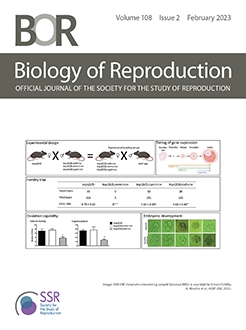Xueying Wang, Qinghua Liu, Jun Li, Li Zhou, Tao Wang, Ning Zhao
Biology of Reproduction 108 (2), 1-15, (22 February 2023) https://doi.org/10.1093/biolre/ioac203
KEYWORDS: Sebastes schlegelii, internal fertilization, spermatogenesis, spermiogenesis, single-cell RNA-seq
Spermatogenesis is a dynamic cell developmental process that is essential for reproductive success. Vertebrates utilize a variety of reproductive strategies, including sperm diversity, and internal and external fertilization. Research on the cellular and molecular dynamic changes involved in viviparous teleost spermatogenesis, however, is currently lacking. Here, we combined cytohistology, 10 × genomic single-cell RNA-seq, and transcriptome technology to determine the dynamic development characteristics of the spermatogenesis of Sebastes schlegelii. The expressions of lhcgr (Luteinizing hormone/Choriogonadotropin receptor), fshr (follicle-stimulating hormone receptor), ar (androgen receptor), pgr (progesterone receptor), and cox (cyclo-oxygen-ase), as well as the prostaglandin E and F levels peaked during the maturation period, indicating that they were important for sperm maturation and mating. Fifteen clusters were identified based on the 10 × genomic single-cell results. The cell markers of the sub-cluster were identified by their upregulation; piwil, dazl, and dmrt1 were upregulated and identified as spermatogonium markers, and sycp1/3 and spo11 were identified as spermatocyte markers. For S. schlegelii, the sperm head nucleus was elongated (spherical to streamlined in shape), which is a typical characteristic for sperm involved in internal fertilization. We also identified a series of crucial genes associated with spermiogenesis, such as spata6, spag16, kif20a, trip10, and klf10, while kif2c, kifap3, fez2, and spaca6 were found to be involved in nucleus elongation. The results of this study will enrich our cellular and molecular knowledge of spermatogenesis and spermiogenesis in fish that undergo internal fertilization.
Summary Sentence
In S. schlegelii, luteinizing hormone can induce prostanoid production owing to cox upregulation and prostaglandin may be a key pheromone in copulation and sperm maturation.







